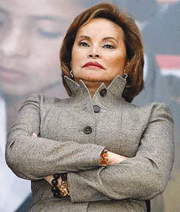It is perhaps the hardest reform of all. pension systems or energy shortages can be fixed by cutting entitlements or spending more. But no amount of money can in itself make a million qualified teachers materialise in less than a generation. That is the aim of the Alliance for Educational Quality launched by Felipe Calderon, Mexico’s president, in May. To signal its importance, he gathered together much of his cabinet for the signing ceremony on May 15. The document his pen hovered over was not a new law, but rather an agreement with Elba Esther Gordillo, head of the national teachers’ union.
 Ms. Gordillo is a powerful political figure in Mexico. Her critics contend that she is more a politician than an educator, and say that her union has long been an obstacle to improving education. But President Calderon is by nature a pragmatic deal-maker, and ignoring the union would only have led to a hopeless stalemate.
Ms. Gordillo is a powerful political figure in Mexico. Her critics contend that she is more a politician than an educator, and say that her union has long been an obstacle to improving education. But President Calderon is by nature a pragmatic deal-maker, and ignoring the union would only have led to a hopeless stalemate.
The need for good teachers is glaring. Mexico was placed dead last among members of the Organisation for Economic Cooperation and Development (OECD), a club of mainly developed countries, in reading, science and mathematics in December by the Programme for International Student Assessment (PISA). Look beyond simple place rankings and the picture gets worse. On the reading part of the test, less than 1 percent of Mexican 15-year-olds scored as “capable of sophisticated, critical thinking” (compared with 22 percent in South Korea, the top scorer).
The main problem lies not with salaries for teaching, which are competitive with other jobs in Mexico but with the quality of teachers. The government has been trying to solve the problem since 1992, when it introduced annual bonuses linked to teachers’ participation in training courses and their scores in tests. This system is far from perfect. A study last year by the Rand Corporation, an American think-tank, found that the tests given to teachers required “only low level cognitive responses”, while the criteria for evaluation were fuzzy and subject to manipulation.
The new agreement between President Calderon and Ms. Gordillo has two aims. First, there is a promise to improve the fabric of the 27,000 schools — around one in eight — that are in poor repair (though no new money was allocated to this as part of the agreement). Second, it seeks to break the hold of the union over teachers’ careers. Under the agreement, teachers would be hired and promoted according to how they fare in tests devised and marked by a new independent body.
The reaction of education experts to the deal has been muted. Many find it hard to believe that the union will concede its power over hiring and firing in a meaningful way. They also note that Ms. Gordillo has a knack of co-opting reforms to serve her own ends. Yet Josefina Vasquez Mota, the minister of education, is one of President Calderon’s more able political operators. If she can make the agreement stick in practice, the quality of Mexican schooling should gradually improve.
(Excerpted and adapted from The Economist)